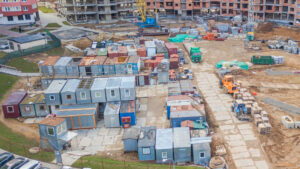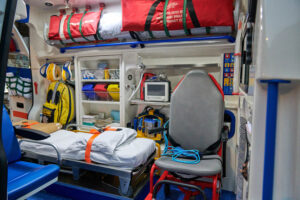
What’s Included in Oil and Gas Facilities Management
Oil and gas facilities management is a complex and critical discipline that ensures energy operations in Canada’s most remote locations

The process of gas remote camp mobilization in Canada is a critical operation that supports the development and maintenance of gas extraction and processing sites in remote and often harsh environments. With increasing activity in Canada’s vast natural gas sector—particularly in regions such as British Columbia, Alberta, and parts of Northern Canada—establishing functional and sustainable camps in remote areas is not only a logistical challenge but a vital step toward project success. Canada ranks 5th globally in natural gas production, generating over 190 billion cubic meters annually, making efficient camp mobilization a foundational element in sustaining this high-output industry.
This process involves the planning, transportation, construction, and operational setup of camps that support workforce and infrastructure at isolated gas field locations.
These camps vary in size and complexity:
Mobilizing these camps involves:
A qualified camp management company is essential for success. These companies oversee every stage of camp development, from design to daily operations.
They provide services such as:
In the context of gas remote camp management, the goal is to build not just a functional remote work camp—but a livable environment that keeps workers safe, healthy, and productive.
In addition to essential services, some camp management companies also offer remote security systems such as surveillance towers, motion-triggered cameras, and centralized monitoring to protect high-value assets and ensure personnel safety in isolated locations.
The logistics of gas remote camp services are complex and must begin well in advance of project mobilization. Strategic planning ensures that all resources, infrastructure, and personnel arrive on time and that the camp can be operational under extreme environmental and geographic constraints.
Key planning considerations include:
Planning also includes considerations for remote site access controls, ensuring only authorized personnel and vehicles can enter critical work zones, often using digital passes, geofencing, or biometric checkpoints.
Critical components mobilized:
Careful coordination with transport companies is essential to manage heavy loads, seasonal access restrictions, and the sequencing of delivery for all components. Timing, route planning, and weather forecasting play critical roles in ensuring successful and cost-efficient mobilization of camp infrastructure.
Once the camp is established, maintaining operations in a remote area requires a combination of expertise, automation, and redundancy. Without reliable infrastructure and ongoing support systems, even well-built camps can experience operational disruptions that impact productivity, safety, and timelines.

One of the most valued aspects of remote work camps is access to reliable, nutritious meals. That’s where gas food catering services come in.
Services typically include:
Larger camps may also provide gas remote food catering services integrated with recreation and wellness amenities such as:
These services improve morale, lower turnover, and support physical and mental health in high-stress work environments.
Canada enforces strict environmental and safety standards on all industrial activities—especially those operating in remote and sensitive areas.
Compliance Measures Include:
The use of specialized buildings like an explosion proof portable building ensures safety in areas with high concentrations of volatile gases or flammable materials.
In many projects, local Indigenous communities are active partners in planning, construction, and operations—helping ensure economic inclusion and environmental stewardship.
Sustainable practices are no longer optional—they’re expected. Many operators now prioritize green technologies and flexible construction models to meet evolving standards and reduce environmental impact.
Notable innovations in gas remote camp mobilization:
With the adoption of these technologies, camps are becoming smarter, safer, and more efficient.
Establishing and operating remote camps in Canada’s gas sector demands a strategic blend of planning, logistics, infrastructure, and workforce support. From modular construction and scalable designs to renewable energy integration and Indigenous engagement, the requirements for success are both technical and human. As the industry continues to push into more isolated and environmentally sensitive regions, the importance of safety, sustainability, and innovation will only grow. In this evolving landscape, the ability to execute efficient and compliant gas remote camp mobilization will remain a defining factor in long-term project success.
Ensure the success of your remote gas operations.
Contact the Domco Group today and schedule a consultation with our experienced team to explore tailored solutions for your remote camp mobilization needs.
Domco Group of Canada Limited is one of the most trusted and well respected remote sites service providers in Canada. Fully Canadian and independently owned, Domco has been in operation since 1945. We offer integrated remote site solutions, including a nutritious and well planned menu cycle, long-term relationship building, and deep Canadian roots in remote locations with Aboriginal communities.
Let us take you through some key advantages that set us apart.

Oil and gas facilities management is a complex and critical discipline that ensures energy operations in Canada’s most remote locations

In the rugged, often isolated world of remote construction camps, construction facility management is the invisible force that sustains daily

Remote maintenance is the backbone of operational continuity in Canadian work camps, especially those located in isolated regions supporting industries

Remote camp health and safety is a vital concern in the management of Canadian remote workforce camps, especially in resource-driven

Keeping crews energized and satisfied starts with smart camp food menu ideas—especially in remote environments where morale and nutrition go

Gas remote camp mobilization is a critical operational phase in Canada’s oil and gas industry, particularly in remote and northern

When it comes to remote site security in Canadian work camps, ensuring safety and protection is paramount. These facilities, often

In Canada’s vast and resource-rich landscapes, remote site maintenance plays a pivotal role in sustaining the operations of work camps

In Canada’s vast and often isolated regions, remote camp management plays a vital role in advancing sustainability across diverse work

Remote site administration is a vital function in Canada’s most geographically isolated and operationally demanding environments. From the Arctic’s frozen

Developing a sustainable infrastructure for a remote camp facility located in the rugged, often isolated regions of Canada—such as the

In Canada’s vast and rugged landscapes, remote facility catering has evolved from a logistical challenge into a platform for sustainable

Budgeting for facility repair and maintenance in remote Canadian work sites is no small task. When miles away from urban

The process of gas remote camp mobilization in Canada is a critical operation that supports the development and maintenance of

Remote facility chefs are the unsung heroes of Canada’s sprawling wilderness operations—from fly-in camps tucked into diamond-rich tundras to energy
